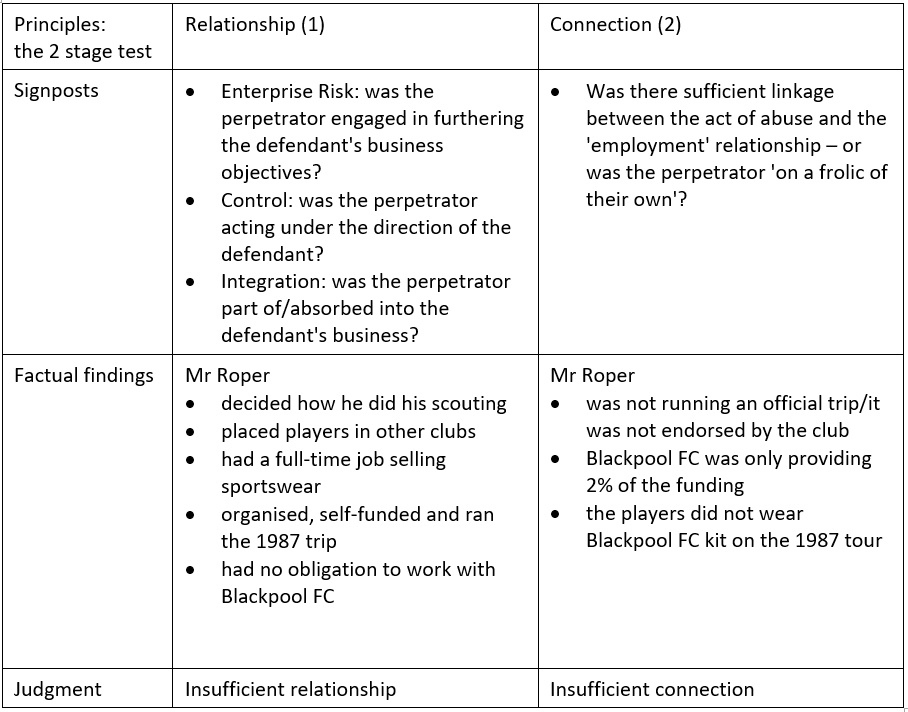Blackpool Football Club Ltd v DSN [2021] EWCA Civ 1352
Introduction
Reliance upon 'independent contractors' in the healthcare arena has provided fertile ground for debates around who should carry responsibility for adverse treatment outcomes, with claimants arguing that vicarious liability and/or a non-delegable duty of care should widely apply (see Ramdhean, Breakingbury and Hughes).
In this 61 page judgment, the Court of Appeal explored vicarious liability, the context being the actions of a talent scout, found to have abused a young player on a football tour to NZ and Thailand in 1987. The finding assists those defending vicarious liability arguments, the Court of Appeal reversing the decision at first instance and concluding that the club could not be held responsible for the actions of the deceased perpetrator.
This article explores the principles of relationship and connection underlying findings of vicarious liability and what signposting can be taken for defending future claims. It does not address the other issue that was unsuccessfully appealed, namely limitation and the discretionary extension under s.33 of the Limitation Act 1980.
The context
The claimant was aged 13 when he was abused by a talent scout (Mr Frank Roper – deceased) during a football tour to NZ and Thailand in 1987. Mr Roper was a convicted sexual offender (1960s and 1984) who died in 2005. The claimant (due to the mental trauma) did not disclose the abuse to anyone until 2013 when he told his wife. The police were notified in 2016, and solicitors instructed in 2017. Proceedings were issued against Blackpool FC in 2018, on the basis that Mr Roper, whilst an unpaid volunteer, was effectively under the club's control, recruiting players for the club who could then sell them on, generating vital income.
Vicarious Liability: principles and arguments
The legal principle of placing fault on a party who is not the perpetrator is a limited but well established one, driven by two factors;
- the relationship between the defendant and perpetrator (here Blackpool FC and Mr Roper), and
- the connection between the perpetrator's actions and their performance of that relationship.
Determining the true nature of the relationship between Mr Roper and Blackpool FC absorbed much of this judgment. As we know, in cases where there is a 'conventional' arrangement of employer/employee, the relationship is a given. There was no such contract between Mr Roper and the club. What was required here, was therefore an intense and fact sensitive analysis to establish if the relationship (Blackpool FC/Roper) was 'akin to employment'.
It should be noted that the decision of the trial judge was conveyed before the Supreme Court handed down their findings in Barclays Bank and Morrison No. 2. This helps explain the success of the appeal after a very detailed review of the authorities and dissection of the facts.
The question before the Court of Appeal was, should Blackpool FC be held vicariously liable for the actions of Mr Roper, who was found to have abused the claimant? Providing the opportunity for abuse to occur was not sufficient. For the defendant to be liable, there would need to be a sufficiently close relationship (defendant/perpetrator) as well as a connection between the event of abuse and that relationship.

What does this decision mean for vicarious liability arguments in a healthcare context?
As those that have been following case law in the healthcare context will be aware, there has been a recent run of cases that have found (specifically in the dental context) that patients can establish vicarious liability against a practice owner rather than pursue the negligent practitioner, relying on a relationship (practice owner/self-employed associate) as being akin to employment.
In this judgment, the policy rationale behind vicarious liability was fully explored; it being noted that in the conventional employer/employee contractual relationship, such liability is fair, just and reasonable, but not so in unconventional relationships. The Court of Appeal referenced the comments of Lord Steyn in Bernard v AG for Jamaica [2004] that the policy rationale behind vicarious liability was not just "… a vague notion of justice", it having "clear limits", and it being "not infinitely extendable".
For those who had been encouraged by the Barclays decision and then depressed by the more recent run of first instance decisions, this case provides some reassurance that there are limits and that the court is prepared to apply them, even when it results in a claimant not being able to achieve redress.
If your require further information, please contact the author Vicki Swanton, Healthcare Partner.













